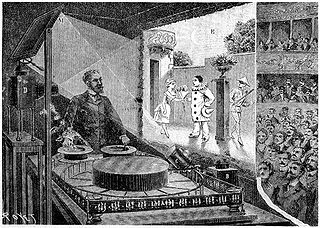Related Research Articles

Betty Boop is an animated cartoon character designed by Grim Natwick at the request of Max Fleischer. She originally appeared in the Talkartoon and Betty Boop film series, which were produced by Fleischer Studios and released by Paramount Pictures. She was featured in 90 theatrical cartoons between 1930 and 1939. She has also been featured in comic strips and mass merchandising.

Talkartoons is a series of 42 animated cartoons produced by Fleischer Studios and distributed by Paramount Pictures from 1929 to 1932.
The silent age of American animation dates back to at least 1906 when Vitagraph released Humorous Phases of Funny Faces. Although early animations were rudimentary, they rapidly became more sophisticated with such classics as Gertie the Dinosaur in 1914, Felix the Cat, Oswald the Lucky Rabbit, and Koko the Clown.

Charles-Émile Reynaud was a French inventor, responsible for the praxinoscope and was responsible for the first projected animated films. His Pantomimes Lumineuses premiered on 28 October 1892 in Paris. His Théâtre Optique film system, patented in 1888, is also notable as the first known instance of film perforations being used. The performances predated Auguste and Louis Lumière's first paid public screening of the cinematographe on 26 December 1895, often seen as the birth of cinema.

Myron "Grim" Natwick was an American artist, animator, and film director. Natwick is best known for drawing the Fleischer Studios' most popular character, Betty Boop.

The Théâtre Optique is an animated moving picture system invented by Émile Reynaud and patented in 1888. From 28 October 1892 to March 1900 Reynaud gave over 12,800 shows to a total of over 500,000 visitors at the Musée Grévin in Paris. His Pantomimes Lumineuses series of animated films include Pauvre Pierrot and Autour d'une cabine. Reynaud's Théâtre Optique predated Auguste and Louis Lumière's first commercial, public screening of the cinematograph on 28 December 1895, which has long been seen as the birth of film.
Bimbo's Initiation is a 1931 Fleischer Studios Talkartoon animated short film starring Bimbo and featuring an early version of Betty Boop with a dog's ears and nose. It was the final Betty Boop cartoon to be animated by the character's co-creator, Grim Natwick, prior to his departure for Ub Iwerks' studio.
The Grim Natwick Film Festival is an annual film festival, inaugurated in 2010. The three-day festival is held every summer in Wisconsin Rapids, Wisconsin.
Events in 1940 in animation.
1990 in animation is an overview of notable events, including notable awards, list of films released, television show debuts and endings, and notable deaths.
Events in 1938 in animation.
Events in 1935 in animation.
Events in 1933 in animation.
Events in 1918 in animation.
Events in 1894 in animation.
Events in 1892 in animation.
Events in 1889 in animation.
Events in 1888 in animation.
Events in 1879 in animation.
Events in 1877 in animation.
References
- ↑ "Charles-Émile Reynaud". Who's Who of Victorian Cinema. Retrieved 2007-03-11.
- ↑ "Théâtre optique (Reconstitution) (AP-95-1724) - Collection - Catalogue des appareils cinématographiques - la Cinémathèque française".
- ↑ Tissandier, Gaston (1892-07-23). Le Théâtre optique de M. Reynaud.
- ↑ "The moving picture shows of Émile Reynaud | United Nations Educational, Scientific and Cultural Organization".
- ↑ "Gayne Whitman". The New York Times. 4 September 1958.
- ↑ "Thoralf Klouman". Store norske leksikon (in Norwegian). Oslo: Kunnskapsforlaget. Retrieved 24 November 2009.
- ↑ Berg, Thoralf. "Thoralf Klouman". In Helle, Knut (ed.). Norsk biografisk leksikon (in Norwegian). Oslo: Kunnskapsforlaget. Retrieved 24 November 2009.
- ↑ "Here's What Happened to Disney's Original 'Winnie the Pooh' Voice Cast". August 3, 2020.
- ↑ "Junius Matthews - 2 Character Images". Behind The Voice Actors.
- ↑ Krows, Edwin (September 1939). "Motion Pictures-Not for Theatres". The Educational Screen. VVIII: 244 . Retrieved Apr 14, 2019.
- ↑ "Award will honor World War Writers". Motion Picture Daily: 2. Jul 8, 1947. Retrieved Apr 14, 2019.
- ↑ "Arch Heath, Veteran Film Executive, is Stricken". Boxoffice. Jan 13, 1945. Retrieved Apr 14, 2019.
- ↑ Wilson, Scott (19 August 2016). Resting Places: The Burial Sites of More Than 14,000 Famous Persons, 3d ed. McFarland. p. 238. ISBN 978-1-4766-2599-7 . Retrieved November 21, 2021.
- ↑ "George Debels". www.nicodubois.com. Retrieved May 20, 2020.
- ↑ "Joe Stan". lambiek.net. Retrieved May 20, 2020.
- ↑ "Myron Grim Natwick,Original Creator of Betty Boop". Archived from the original on November 30, 2010. Retrieved August 2, 2020.
- ↑ "Myron Natwick, 100; Animated Betty Boop". The New York Times . October 10, 1990. Retrieved August 2, 2020.
- ↑ Williams, Richard (2009). The Animator's Survival Kit: Expanded Edition. Farrar, Straus, and Giroux. p. 35. ISBN 978-0-86547-897-8.
- ↑ Myron "Grim" Natwick (Hollywood Cartoon Hall of Fame) Archived May 20, 2009, at the Wayback Machine
- ↑ Leonard Maltin (1980). Of mice and magic. Internet Archive. McGraw Hill Higher Education; 1ST edition. p. 96. ISBN 978-0-07-039835-1.
- ↑ Worth, Stephen (2022-03-16). "Exhibit: Grim Natwick- Golden Age Animator". AnimationResources.org - Serving the Online Animation Community. Retrieved 2022-07-26.
- ↑ Culhane, Shamus (1986). Talking animals and other people. Internet Archive. New York : St. Martin's Press. p. 80. ISBN 978-0-312-78473-7.
- ↑ Leonard Maltin, Of Mice and Magic: A History of American Animated Cartoons (NAL and McGraw Hill, 1980; revised edition, November 1987), p. 242
- ↑ Mazurkewich 1999, p. 13-16.
- ↑ Neal Gabler (2007). Walt Disney: The Triumph of the American Imagination. Vintage Books. pp. 431–. ISBN 978-0-679-75747-4.
- ↑ Eisner, Judith A. (September 24, 1970). "The fabulous career Byington Ford". archive.org. Carmel Pine Cone. Retrieved 2020-04-11.
- ↑ "Byington Ford". Carmel Pine Cone. Carmel-by-the-Sea, California. 1985-01-31. Retrieved 2020-09-23.
- ↑ Markstein, Don. Toonopedia.
- ↑ Lambiek
- ↑ "K-Hito". lambiek.net. Retrieved May 29, 2020.
- ↑ The Animated Cartoon Factory – History of Animation Timeline
- ↑ Yayyan, la separata cultural de Jaén·on·line